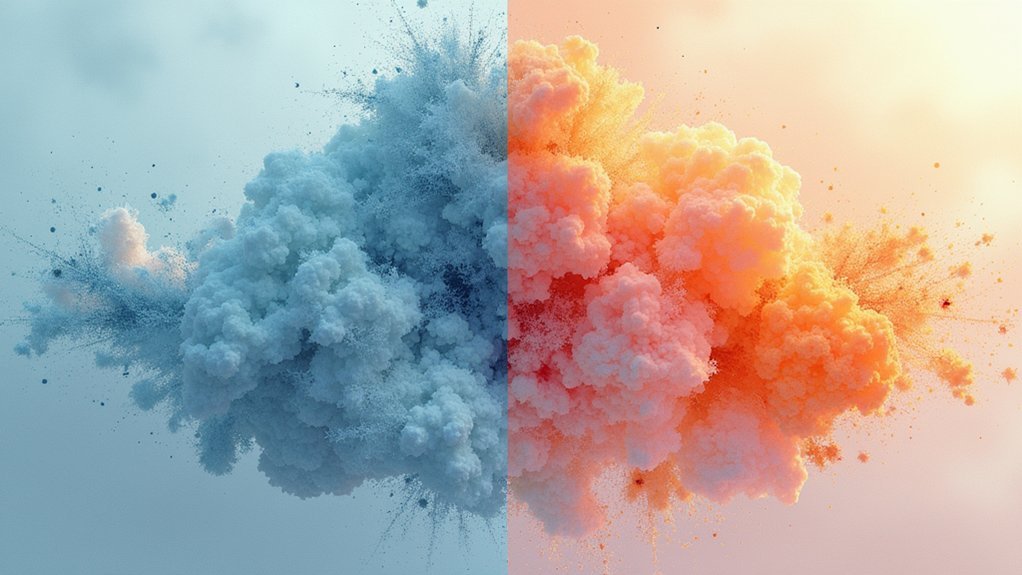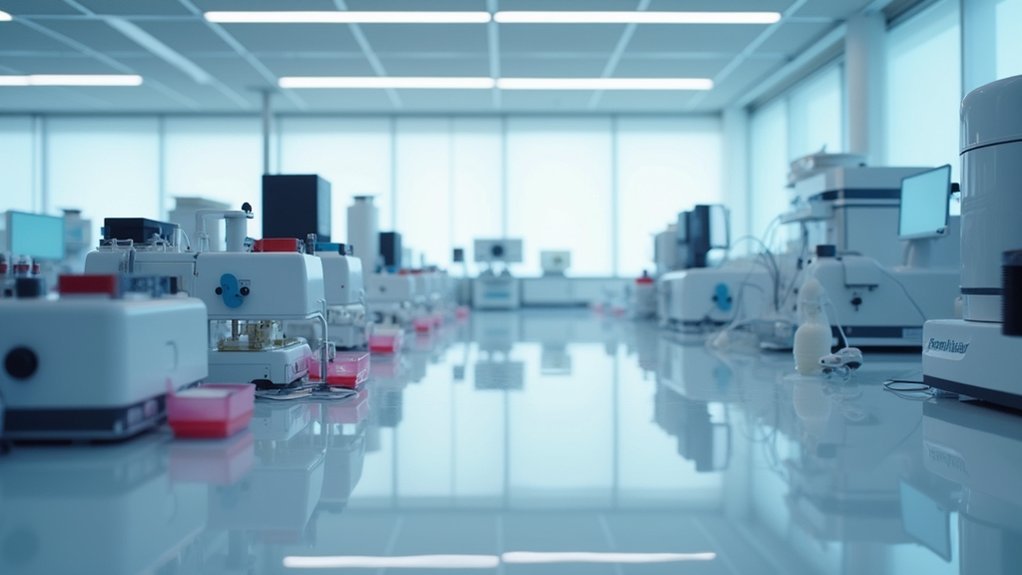Effective noise reduction in scientific microscopy images requires understanding both noise sources and advanced algorithms like BM3D. You’ll achieve better results by implementing transform domain filtering and block matching techniques while maintaining critical specimen details. Use specialized software tools like Photoshop’s layer masking or Topaz DeNoise for targeted adjustments, and evaluate your results with PSNR and SSIM metrics. The following techniques will transform your scientific imagery from noisy to publication-ready.
Numeric List of Second-Level Headings

Seven essential sections comprise our advanced noise reduction guide, each targeting specific aspects of the denoising workflow. You’ll progress through:
- Understanding Image Noise Types
- Separating Luminance and Chrominance Noise
- Layer-Based Selective Denoising Techniques
- Implementing BM3D Algorithms for Superior Results
- Measuring Success: PSNR and SSIM Analysis
- Masking Strategies for Detail Preservation
- Software-Specific Workflows and Recommendations
Each section builds upon fundamental image processing concepts while introducing advanced techniques to combat read noise without sacrificing image quality.
You’ll learn to identify when different approaches yield ideal results and how to customize your workflow based on image characteristics.
The guide emphasizes practical applications rather than theory alone, ensuring you’ll develop skills to handle even challenging scientific imagery with confidence.
Understanding Noise Sources in Microscope Imagery
Sensor thermal fluctuations are likely the culprit behind those random speckles you’ll notice in your microscope images, especially during extended imaging sessions.
You’re also battling photon counting statistics, which create shot noise when too few photons reach your detector during low-light observations.
Understanding these fundamental noise sources will help you implement more targeted reduction strategies rather than applying generic filters that might compromise valuable image details.
Sensor Thermal Fluctuations
While capturing high-resolution microscope images, you’ll inevitably encounter one of the most persistent enemies of image clarity: thermal fluctuations within the sensor.
As your camera sensor heats up during operation, the level of noise increases considerably, introducing grainy artifacts that mask fine details in your specimens.
You’ll notice these fluctuations dramatically affect image characteristics, especially when using higher ISO settings. The warmer your sensor becomes, the more random variations appear in pixel values, degrading overall image quality.
To combat this issue, consider implementing cooling solutions like thermoelectric devices that stabilize sensor temperature.
Regular calibration of your microscopy system is essential. By monitoring and controlling sensor temperatures, you’ll achieve more consistent results and cleaner scientific imagery that accurately represents your research findings.
Photon Counting Statistics
When examining the fundamental sources of noise in microscope imagery, you’ll find that photon counting statistics represent the most unavoidable noise factor inherent to imaging itself. This noise follows a Poisson distribution where variance equals the mean—directly impacting your signal-to-noise ratio, especially in fluorescence microscopy’s low-light conditions.
Unlike other types of noise, shot noise is proportional to the square root of signal intensity, making it particularly problematic when photon counts are low. You’ll notice this in your raw files as grainy fluctuations that obscure fine details.
Beyond shot noise, your images also contend with readout noise and dark current during long exposures.
Need help optimizing your calibration or implementing denoising algorithms like BM3D? Contact us for assistance in recovering clearer, more scientifically valuable microscopy data.
Fundamentals of Transform Domain Filtering

You’ll find that transform domain filtering transforms noisy images into frequency-based representations where noise often becomes more distinguishable from actual image content.
This conversion opens up powerful noise reduction capabilities by allowing you to manipulate specific frequency components while preserving essential image details, with methods like the BM3D algorithm leveraging this approach to group similar image blocks for effective collaborative filtering.
Processing in frequency space offers significant advantages over spatial domain techniques, particularly when dealing with complex noise patterns in microscope imagery that might otherwise obscure critical visual information.
Transform Domain Filtering Fundamentals
Unlike spatial domain methods that operate directly on pixel values, transform domain filtering tackles noise reduction by converting images into alternative mathematical representations where noise is more easily separated from genuine image content. This approach transforms your original image using mathematical operations like the Discrete Cosine Transform (DCT), creating a domain where noise patterns become distinct from image features.
The widely acclaimed BM3D algorithm exemplifies the power of transform domain techniques by grouping similar image blocks into 3D arrays for collaborative filtering.
You’ll find this method particularly effective across different types of noise contamination. After applying Wiener filtering in the transform domain, the process converts data back to spatial representation and aggregates information from overlapping blocks, preserving fine details while removing unwanted noise—a critical advantage in scientific imaging applications.
Domain Conversion Benefits
The transformation of images from spatial to frequency domains represents a pivotal advantage in advanced noise reduction techniques. When you convert your noisy images to transform domains like DCT, you’re enabling more powerful filtering operations that simply aren’t possible in the spatial domain.
This conversion allows you to exploit similarities across grouped image blocks, as seen in the BM3D algorithm. By organizing similar blocks into 3D arrays within the transform domain, you’ll achieve collaborative filtering that notably outperforms traditional methods.
The two-step BM3D process—applying Wiener filtering in the transform domain followed by aggregation—preserves fine details and textures that would otherwise be lost.
For your high-quality applications in medical imaging or photography, transform domain filtering delivers superior results by maintaining critical image features while effectively removing noise.
Frequency Space Processing
While spatial domain filters directly modify pixel values, frequency space processing transforms your image into a domain where noise and signal occupy different regions, making them easier to separate. This approach, exemplified by the Discrete Cosine Transform (DCT), allows you to target noise more precisely during denoising.
Advanced algorithms like BM3D leverage this concept by collecting similar image blocks into 3D arrays before applying collaborative filtering in the transform domain. Wiener filtering can then be implemented to preserve vital details while eliminating unwanted noise.
After processing, you’ll convert the data back to the spatial domain through inverse transformation. The final step involves aggregation, where overlapping blocks are weighted and combined to guarantee consistent noise reduction throughout your image while maintaining structural integrity.
BM3D Algorithm: Principles and Implementation

Since its development, BM3D (Block-Matching and 3D filtering) has emerged as one of the most powerful noise reduction algorithms in digital image processing.
You’ll find BM3D particularly effective because it divides your images into overlapping blocks and groups similar ones to enhance collaborative filtering.
The algorithm works through a two-step process: first applying Wiener filtering in the transform domain to each group, then aggregating the processed blocks into your final denoised image.
BM3D leverages the Discrete Cosine Transform (DCT) to convert grouped blocks into the frequency domain, notably improving noise reduction performance.
You’ll appreciate BM3D’s exceptional ability to preserve textures while removing noise—making it ideal for medical imaging and photography applications where detail retention is essential.
Block Matching Techniques for Similar Pattern Recognition
When analyzing noise reduction at a deeper level, you’ll discover that block matching forms the foundation of advanced algorithms like BM3D. This approach divides your image into overlapping blocks, then groups similar patterns together to enhance collaborative filtering effectiveness.
The process relies on distance metrics, typically Euclidean, to quantify block similarities. By identifying and grouping similar image segments into 3D stacks, you’re leveraging the inherent redundancy in image data—a critical step that preserves textures and fine details during denoising.
The power of block matching lies in its ability to recognize similar patterns across different image regions. When implemented correctly, this technique notably improves noise reduction outcomes while maintaining image integrity, making it essential for scientific imaging applications where detail preservation is paramount.
Collaborative Filtering Strategies for Scientific Images

Building upon the block matching framework, collaborative filtering elevates scientific image denoising to remarkable new heights. When you apply this approach through algorithms like BM3D, you’re leveraging the power of similarity between overlapping image blocks to preserve critical details while eliminating noise.
The process works in two key stages: first, you’ll apply Wiener filtering in the transform domain to groups of similar blocks. By stacking these blocks into 3D arrays and converting them to frequency domains using DCT, you’re enabling more precise noise identification and removal.
In the final aggregation step, you’ll combine weighted information from overlapping blocks to produce a clean image that maintains fidelity to your original data.
What makes this technique particularly valuable is its adaptability to various noise levels across different scientific imaging applications.
Autoencoder Models for Microscope Image Denoising
Autoencoder models with convolutional layers create powerful denoising systems that you’ll find particularly effective for cleaning up noisy microscope images while preserving critical details.
You can implement these models using UpSampling2D and Conv2D layers, compiling them with Adam optimizer and binary crossentropy loss for peak performance on your scientific datasets.
Your lab can benefit from real-time denoising applications that continuously improve through EarlyStopping callbacks, allowing for immediate visualization and analysis of cleaner microscopy data with higher PSNR and SSIM metrics.
Autoencoder Architecture Basics
Despite their complex appearance, autoencoders function on a surprisingly elegant principle for microscope image denoising. They learn to compress noisy images into a clean representation and then reconstruct them through paired encoding and decoding stages.
The architecture typically combines UpSampling2D and Conv2D layers that work together to extract essential features while discarding noise patterns.
You’ll compile your model using the Adam optimizer and binary crossentropy loss for optimal outcomes when training with noisy-clean image pairs.
Implement an EarlyStopping callback to monitor validation loss and prevent overfitting during training.
Once trained, you can evaluate your autoencoder’s performance using PSNR and SSIM metrics to quantify denoising effectiveness.
Visualizing predictions alongside original and noisy inputs provides clear evidence of your model’s noise reduction capabilities.
Real-time Denoising Applications
While sophisticated denoising algorithms have existed for years, implementing them for real-time applications presents unique challenges worth addressing. You’ll find autoencoders particularly effective for microscopy work, where preserving critical details while removing noise is essential.
| Application | Implementation Approach |
|---|---|
| Live microscopy | UpSampling2D with Conv2D layers for immediate processing |
| Automated pathology | EarlyStopping callbacks to maintain performance |
| Research imaging | PSNR and SSIM metrics for quality control |
| Clinical diagnostics | Visualization of predictions for real-time assessment |
When implementing real-time denoising, you’re balancing computational efficiency with accuracy. The training process requires noisy images as input and clean images for validation, optimizing your model to generalize well across various noise profiles. This approach guarantees your microscope imagery maintains structural integrity while noise is effectively reduced.
PSNR and SSIM: Quantifying Denoising Performance

When evaluating the effectiveness of noise reduction techniques, you’ll need objective metrics to measure success. Two standard metrics stand out: Peak Signal to Noise Ratio (PSNR) and Structural Similarity Index (SSIM).
PSNR measures image quality in decibels, with values above 30 dB typically indicating acceptable quality. It’s calculated using PSNR = 10 * log10((MAXf^2) / MSE), where MSE represents the mean squared error between original and processed images.
Meanwhile, SSIM provides a more perceptually aligned assessment by evaluating luminance, contrast, and structure. Its values range from -1 to 1, with 1 indicating perfect similarity. SSIM incorporates small constants to avoid division-by-zero errors during calculations.
Both metrics are essential tools in algorithm development and quality assessment for denoising applications like BM3D.
Practical Workflow for Microscope Image Processing
Microscope image processing demands a systematic approach to preserve scientific accuracy while enhancing visibility. Start by evaluating your camera’s ISO performance, as this directly impacts noise characteristics in your scientific images.
Implement your workflow using a layer-based strategy in software like Photoshop, allowing you to target specific areas with different noise reduction intensities. Apply advanced algorithms such as BM3D to effectively reduce noise while maintaining critical microscopic details.
When adjusting settings, distinguish between chrominance and luminance noise, using dedicated sliders to balance reduction without sacrificing sharpness.
For objective quality assessment, employ PSNR and SSIM metrics to quantify your results before finalizing the image.
This structured approach guarantees your microscope images retain their scientific integrity while achieving maximum clarity for analysis and presentation.
Layer-Based Noise Reduction for Complex Specimens
Because complex specimens exhibit varying noise patterns across different structures, layer-based noise reduction offers unparalleled control for microscopy image processing. By creating separate layers for distinct elements—background, details, and specific features—you’ll apply tailored adjustments where needed most.
Layer masking is your key tool for selective noise reduction. Use a hard brush with a soft edge to reveal or conceal specific areas with precision, maintaining fine detail integrity while addressing problematic regions. Tools like Topaz DeNoise work effectively within this layered approach.
This method consistently outperforms traditional techniques in side-by-side comparisons. You’ll achieve a cleaner appearance with sharper details by addressing each specimen component individually rather than applying global adjustments that compromise critical structures.
Balancing Detail Preservation and Noise Removal
Finding the ideal balance between noise reduction and detail preservation represents the fundamental challenge in microscopy image processing. When you apply noise reduction techniques like BM3D, you’ll need to make critical adjustments to maintain important specimen details while effectively eliminating unwanted noise.
| Approach | Benefits | Considerations |
|---|---|---|
| Layer masking | Targeted application | Requires precise selection |
| Luminance/Chrominance sliders | Separate control of brightness and color noise | Different best settings for various specimens |
| Metric-guided adjustment | Quantitative quality assessment | PSNR and SSIM provide objective feedback |
You can evaluate your noise reduction effectiveness using PSNR and SSIM metrics, where higher PSNR values and SSIM scores closer to 1 indicate better results. Consider creating adjustment layers in your workflow to apply different noise reduction intensities to various regions of your microscopy images.
Camera-Specific ISO Performance in Microscopy
Although many microscopists focus primarily on optics and specimen preparation, your camera’s ISO performance plays an essential role in image quality. Understanding that ISO settings aren’t linear in noise production is vital for best results.
Different cameras exhibit unique ISO characteristics. The Nikon Z9 (base ISO 60) shows increased noise up to ISO 400, but notably, noise decreases at ISO 500.
Similarly, Sony’s A7S Mark III performs best at ISO 1600 despite its base ISO of 80, making it ideal for low-light microscopy.
The Canon R6 demonstrates fluctuating noise levels across various ISO settings, affecting microscopic image quality.
For scientific imaging, cameras with dual gain sensors like the Sony A9 offer superior noise handling at higher ISO values.
You’ll achieve cleaner results by testing your specific camera’s ISO performance under actual microscopy conditions.
Advanced Software Tools for Scientific Image Enhancement
While microscopy hardware determines initial image quality, advanced software tools can dramatically enhance your scientific images by eliminating noise without sacrificing critical details.
Photoshop’s layer masking offers precise control—apply hard brushes with soft edges for smooth shifts between treated and untreated areas.
Layer masking in Photoshop provides surgical precision—blend boundaries seamlessly between processed and natural image areas for optimal scientific visualization.
Lightroom’s slider approach provides balanced noise management: reduce chrominance noise through color adjustments and luminance noise via smoothness controls.
For demanding scientific imagery, Topaz DeNoise’s advanced algorithms excel at preserving fine details while effectively managing high ISO noise.
For best results, compare outputs from different tools. Testing shows that layered approaches often yield superior sharpness and clarity compared to single-solution methods.
This targeted strategy allows you to apply appropriate noise reduction techniques to different image regions, enhancing overall image quality for scientific analysis.
Frequently Asked Questions
What Is the Best Noise Reduction in Lightroom?
The best noise reduction in Lightroom combines balanced luminance and chrominance adjustments. You’ll need to tailor settings to your specific image, adjusting detail preservation while eliminating noise without over-smoothing important textures in your photo.
What Does Noise Reduction Do on Iphone Photos?
Noise reduction on your iPhone photos decreases graininess, especially in low-light shots. It works by analyzing and smoothing out unwanted pixels while preserving important details, making your images look cleaner and more professional.
What Is the Best Filter for Gaussian Noise?
You’ll find the Wiener filter ideal for Gaussian noise as it minimizes mean square error. For better results, try BM3D algorithm which preserves details exceptionally well. Gaussian smoothing works too for simpler applications.
How to Use Denoise AI in Lightroom?
To use Denoise AI in Lightroom, import your noisy image, navigate to the Effects panel, then adjust Luminance and Color sliders. Fine-tune with the Smoothness slider and compare results using the preview toggle.
In Summary
You’ve now mastered the essential techniques to dramatically improve your scientific imagery. By understanding noise sources, applying transform domain filtering, and leveraging block matching algorithms, you’ll preserve critical details while eliminating unwanted artifacts. Remember to tailor your approach to your specific camera’s ISO performance and specimen complexity. With these advanced tools at your disposal, you’re ready to produce cleaner, more accurate microscopy images for your research.





Leave a Reply